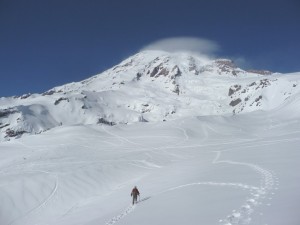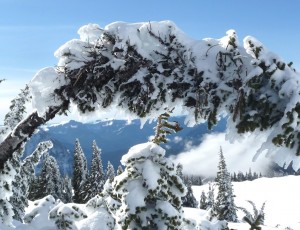| Distance: 3 miles, RT |
|
| Time: 3 hrs |
|
| Elevation Gain: 1,000 ft |
|
| High Point: 6,340 ft |
|
|
|
|
|
In summer, the Paradise flower trails are a world-class attraction, but Mount Rainier is a four-season kind of place for playing outside year-round. In winter, the rolling flower-bedecked meadows change over to a creamy landscape of snow – signs that mark trails become snow-covered hillocks, streams and landmarks buried under mounds of snow. Snowshoers can experience Mt. Rainier’s winter landscape with a gentle, family-friendly climb through the meadows above Nisqually Glacier to Glacier Vista.
<div
The fun begins behind the Henry M. Jackson Visitor Center at Paradise. Basically the route to Glacier Vista follows the Deadhorse Creek Trail. Glacier Vista is more of a bench than a prominence though it is the highest point below Panorama Point. From Glacier Vista, experienced mountaineers can head up to Panorama Point and/or points beyond, including Camp Muir when avalanche danger is minimal.
At the Nisqually entrance ask for the winter recreation map; it designates points of interest, identifies areas prone to avalanche and offers a simple rating system to help you assess how far you’d like to snowshoe. Be sure to get a weather forecast and avalanche forecast before you set out for Paradise.
It’s always a treat to visit Paradise on a sunny day though you must always be prepared for rapidly changing conditions. We timed our visit to take advantage of a brilliant sunny day in February.

Soon after starting out from the sledding area behind the Visitor Center we encountered a cheerful group of policemen training for snow search and rescue; above them we watched the tiny figures of skiers and snowshoers climbing across the gleaming slopes, like ants crawling out of a sugar bowl.
As we climbed, the curved terrain sparkled and twinkled with ice crystals; interspersed with unbroken snow were tracks made by snowshoers and skiers. It’s okay to follow other snowshoe tracks though many snowshoers prefer to make their own. As we traversed the snowy rises and hollows of Mount Rainier’s snowbound parklands, Alta Vista (to the southwest) rose from the snowy slopes like a forested island; the paved trail deep under snow. In summer the meadows surrounding Alta Vista are ablaze with white avalanche lilies; in February the slopes blazed with snow.
Looking south we turned around from time to time to enjoy crystalline views of Mount Adams, Mount Saint Helens and closer peaks of the Tatoosh range including Castle and Pinnacle peaks.
Our plan was to descend the ridge that separates Dead Horse Basin from the Nisqually Glacier but we jettisoned that plan – the snow was too unstable for the descent on steep slopes with few trees to serve as anchors to keep snow from sliding. Instead we continued following the ridge to see how far we could climb given our turnaround time. The ridge was mounded with swirls of snow, like swirls of white icing on cupcakes. Above were several rounded bumps and benches; any of which would serve as a good turnaround or a rest break.

Before we reached Glacier Vista we veered toward Panorama Point to check out a snowy high point covered with trees, the branches so heavy with ice they almost hung to the ground and looked like white paper cutouts against the blue sky. Though we didn’t have time to reach Panorama Point, the tracks of skiers and snowshoers beckoned us onward and upward, at times we utilized the ready-made snowshoe steps, at other times making our own. Speaking of tracks, it’s not only skiers and snowshoers that make tracks in the snow; we also saw faint deer, elk and mouse tracks leading into and out of stands of rime-coated subalpine trees.
The forecast indicated a front moving in later in the day and we watched it approaching from the south, adding a pink tinge to the sky beneath a huddle of clouds on the far horizon. We needed to keep an eye on the weather as it can change quickly.
At the moment the breeze was nil; the temperature just below freezing but in the sun it was warm enough we were in shirtsleeves. While warm temperatures are a treat in winter they can also be deadly – as the day warmed up we watched snowballs rolling down from slopes above us, an indication of instability in the snow pack.
It may be fanciful to believe no harm can come to one in such an inspirational setting but you would be wrong. Skiers and snowshoers themselves can accidentally set off an avalanche by traversing across a steep slope (when in doubt head straight up or down steep snow rather than traverse). Especially avoid snowshoeing under Alta Vista as those slopes are prone to avalanche. Seek gentler slopes and travel close to trees or boulders that help hold the snow in place.
As always turnaround time came too soon so we turned around at Glacier Vista. Here you can get a dizzying view of the Nisqually Glacier but don’t venture too close to the edge as there may be cornices along the ridge.

By the way, did we mention that snowshoeing is hard work? We’ve heard it said more than once that the best exercise for snowshoeing is to snowshoe. Though Glacier Vista is only 1.5 miles from Paradise, on snowshoes it feels like more, especially when the snow is saturated with moisture as it was on our visit.
The snow was too dense to glissade so we plunge-stepped down making the descent short and sweet. There’s something strangely satisfying about punching through untrammeled snow, akin perhaps to the joy that kids feel when they break the ice on a mud puddle or stamp on bubblewrap used in packing.
As we headed down we watched the front edge closer; looking back to Mount Rainier we watched a cap settle on the summit; mist and lack of visibility would be sure to follow.
To get there: From the Nisqually Entrance of the park drive to Paradise via the Nisqually-Vista Paradise road to the Henry M. Jackson Memorial Visitor Center and parking (5,411 feet). The Paradise Road closes in the evening and is gated to uphill traffic at Longmire; double-check with park rangers at the entrance on road-closure times.
For additional information on fees, rules and regulations, current conditions or to obtain an overnight permit call Mount Rainier National Park (360-569-2211) or visit their website at
www.nps.gov/mora/. A backcountry permit is required for over-night camping. Vehicles are required to carry chains. Call the avalanche hotline at 206-526-6677 for the latest avalanche conditions or visit their website at
www.nwac.us.
– Karen Sykes, VisitRainier Hiking Expert
Visit Rainier is a not-for-profit, non-membership destination marketing organization that promotes tourism in the gateway communities around Mt. Rainier.
Connect with Visit Rainier
 Soon after starting out from the sledding area behind the Visitor Center we encountered a cheerful group of policemen training for snow search and rescue; above them we watched the tiny figures of skiers and snowshoers climbing across the gleaming slopes, like ants crawling out of a sugar bowl.
Soon after starting out from the sledding area behind the Visitor Center we encountered a cheerful group of policemen training for snow search and rescue; above them we watched the tiny figures of skiers and snowshoers climbing across the gleaming slopes, like ants crawling out of a sugar bowl. Before we reached Glacier Vista we veered toward Panorama Point to check out a snowy high point covered with trees, the branches so heavy with ice they almost hung to the ground and looked like white paper cutouts against the blue sky. Though we didn’t have time to reach Panorama Point, the tracks of skiers and snowshoers beckoned us onward and upward, at times we utilized the ready-made snowshoe steps, at other times making our own. Speaking of tracks, it’s not only skiers and snowshoers that make tracks in the snow; we also saw faint deer, elk and mouse tracks leading into and out of stands of rime-coated subalpine trees.
Before we reached Glacier Vista we veered toward Panorama Point to check out a snowy high point covered with trees, the branches so heavy with ice they almost hung to the ground and looked like white paper cutouts against the blue sky. Though we didn’t have time to reach Panorama Point, the tracks of skiers and snowshoers beckoned us onward and upward, at times we utilized the ready-made snowshoe steps, at other times making our own. Speaking of tracks, it’s not only skiers and snowshoers that make tracks in the snow; we also saw faint deer, elk and mouse tracks leading into and out of stands of rime-coated subalpine trees. By the way, did we mention that snowshoeing is hard work? We’ve heard it said more than once that the best exercise for snowshoeing is to snowshoe. Though Glacier Vista is only 1.5 miles from Paradise, on snowshoes it feels like more, especially when the snow is saturated with moisture as it was on our visit.
By the way, did we mention that snowshoeing is hard work? We’ve heard it said more than once that the best exercise for snowshoeing is to snowshoe. Though Glacier Vista is only 1.5 miles from Paradise, on snowshoes it feels like more, especially when the snow is saturated with moisture as it was on our visit.
